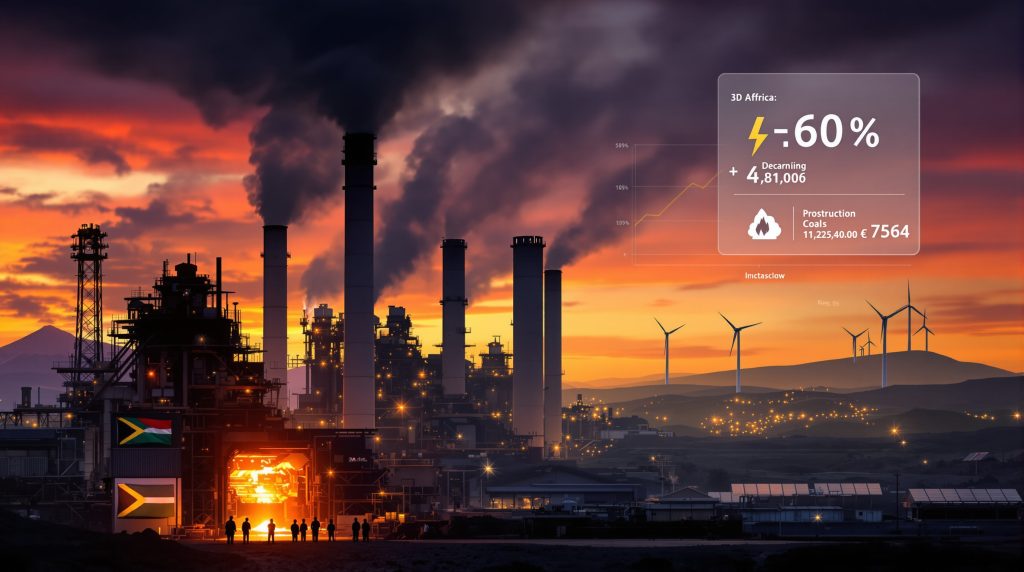What Is Happening to South Africa's Smelter Industry?
South Africa's smelter and alloys industry is experiencing a severe decline, with multiple facilities shutting down or being mothballed in recent years. This industrial contraction has resulted in thousands of job losses and threatens the country's manufacturing capabilities. The primary culprits behind this decline are unreliable power supply and escalating electricity costs, which have made many operations financially unviable.
Key Indicators of Industry Decline
Between 2014 and 2024, approximately 4,596 direct jobs and 16,900 indirect jobs were lost across 10 operations in the alloys industry, according to the Ferroalloy Producers Association (Mining Weekly, September 2, 2025).
ArcelorMittal's long-steel plant closure announcement has placed 3,500 additional jobs at risk, highlighting the ongoing industrial contraction in South Africa.
Assmang's Cato Ridge Smelter in KwaZulu-Natal was closed earlier in 2025, adding to the growing list of shuttered facilities.
Several other operations in the alloys sector have been either mothballed or completely shut down due to operational costs primarily driven by high electricity costs and poor supply reliability.
Why Are Coal Power and Smelters So Interconnected?
The Energy-Intensive Nature of Smelting
Smelting operations require massive amounts of consistent, reliable power to maintain the high temperatures necessary for metal processing. These operations cannot tolerate power interruptions or fluctuations without significant production losses and equipment damage.
Metal smelting requires temperatures ranging from 1,100°C to 1,600°C, making it one of the most energy-intensive industrial processes.
Typical smelters consume between 400-800 kWh per tonne of processed material, representing a substantial energy requirement.
Power costs can represent 30-40% of total operational expenses for smelting facilities, making electricity pricing a critical factor in operational viability.
South Africa's Energy Reality
South Africa's electricity landscape is dominated by coal, which accounts for approximately 80% of the country's power generation. This dependence creates a complex relationship between industrial operations and the country's energy transition goals.
Current Energy Mix Statistics
| Energy Source | Percentage of SA's Power Generation |
|---|---|
| Coal | ~80% |
| Renewables | ~11% |
| Nuclear | ~5% |
| Other sources | ~4% |
According to Vuslat Bayoglu, Managing Director of Menar, coal accounts for two-thirds of power generation globally, with consumption expected to remain above 9 billion tonnes in 2025 (Mining Weekly, September 2, 2025).
What Are the Main Challenges Facing the Industry?
Electricity Supply Reliability Issues
South Africa has faced persistent load shedding (planned power outages) for years, severely impacting industrial operations. Smelters, which require continuous power supply, are particularly vulnerable to these disruptions.
Load shedding can cause catastrophic damage to smelter equipment if power is cut unexpectedly. When molten material solidifies in furnaces due to power loss, it often requires complete rebuilding of the affected equipment.
Restarting furnaces after shutdowns is extremely costly and time-consuming, often requiring days or weeks to return to normal operations.
Unpredictable power supply makes production planning nearly impossible, creating significant operational and financial challenges for smelter operators.
Rising Electricity Costs
As Eskom (South Africa's state power utility) attempts to recover costs and fund infrastructure improvements, electricity prices have risen dramatically, outpacing inflation.
Industrial electricity tariffs have increased by over 500% in the past decade, creating an unsustainable cost structure for energy-intensive industries.
South African industrial electricity prices are now higher than many competing markets, putting local producers at a significant disadvantage.
Energy-intensive industries like smelting are disproportionately affected by these increases, as electricity represents a much larger portion of their operational costs.
Global Market Pressures
The industry faces significant international competition, often from regions with more reliable and affordable power.
Countries with stable, lower-cost electricity have a competitive advantage in energy-intensive industries like smelting.
International markets are increasingly demanding low-carbon products, putting additional pressure on coal-dependent industrial operations.
Trade barriers and carbon border adjustment mechanisms create additional challenges for South African producers in accessing global markets.
What Is the Relationship Between Coal and Industrial Recovery?
The Case for Coal Retention
Despite global pressure to transition away from coal, advocates argue that maintaining coal power is essential for South Africa's industrial sector in the short to medium term.
Coal provides baseload power that renewable sources currently cannot match, ensuring the consistent supply needed for industrial operations.
Existing coal infrastructure represents significant national investment that would be costly to replace prematurely.
Coal mining and power generation support thousands of jobs in regions with limited alternative employment opportunities.
Rapid transition could exacerbate industrial decline without adequate alternatives in place to ensure reliable, affordable power.
According to Bayoglu, South Africa's government recognizes coal as one of the country's top five critical minerals, highlighting its continued importance to the national economy (Mining Weekly, September 2, 2025).
The Energy Transition Dilemma
South Africa faces competing pressures: maintaining industrial competitiveness while meeting climate commitments and transitioning to cleaner energy sources.
The government has committed to retiring coal power plants by 2040, creating a timeline for transition that industries must adapt to.
International climate finance is tied to decarbonization commitments, creating financial incentives for transition but potential short-term industrial challenges.
Renewable energy solutions continue to fall in cost but integration challenges remain, particularly for providing the consistent baseload power that industry requires.
Just transition concerns include protecting coal-dependent communities and workers who would be disproportionately affected by rapid decarbonization.
Bayoglu emphasized that South Africa's energy landscape stands at a decisive crossroads, caught between government recognition of coal as a critical mineral and pressure to discontinue its use (Mining Weekly, September 2, 2025).
How Is Future Electricity Demand Expected to Change?
Growth Sectors Driving Demand
Several emerging sectors are expected to significantly increase South Africa's electricity demand in coming years, complicating the energy transition picture.
Data Center Growth
South Africa is becoming Africa's leading data center hub, with substantial implications for power demand.
South Africa is the fastest-growing data center market on the African continent, according to Bayoglu (Mining Weekly, September 2, 2025).
Modern data centers can consume as much electricity as small towns, creating significant new demand on the power grid.
Global tech companies are expanding their African footprint through South African facilities, driving continued growth in this energy-intensive sector.
The forecast is that significant power capacity will be needed to support this growing sector, adding pressure to an already strained electrical grid.
Industrial Reindustrialization Efforts
Government initiatives aim to revitalize South Africa's manufacturing sector, which would increase power requirements.
The Department of Trade, Industry and Competition has targeted manufacturing growth as a key economic priority.
Special Economic Zones focus on energy-intensive industries as part of economic development strategies.
SA mineral beneficiation is a national priority that would require significant additional power capacity.
Bayoglu emphasized that electricity demand is expected to rise exponentially, with data centers being a leading cause of this growth (Mining Weekly, September 2, 2025).
What Solutions Could Support the Smelter Industry?
Diversified Energy Portfolio
Industry experts advocate for a balanced approach to energy that maintains reliable baseload power while gradually incorporating more renewables.
Maintaining well-functioning coal plants while building renewable capacity could provide a transition path that doesn't sacrifice industrial viability.
Exploring gas as a transition fuel with lower emissions than coal could help bridge the gap between current coal dependence and a renewable future.
Developing energy storage solutions to address intermittency issues is essential for increasing renewable penetration without sacrificing reliability.
Considering small modular nuclear reactors for industrial applications could provide zero-emission baseload power for energy-intensive industries.
Bayoglu advocated for a diversified energy portfolio, emphasizing that this approach represents the only realistic path to reindustrialize South Africa's economy (Mining Weekly, September 2, 2025).
Industrial Energy Efficiency Improvements
Modernizing smelter operations could reduce energy consumption while maintaining production.
Furnace efficiency improvements can reduce energy requirements by 15-30% through technologies like oxygen enrichment and waste heat recovery.
Heat recovery systems can capture and reuse thermal energy that would otherwise be lost, improving overall energy efficiency.
Process optimization through digital technologies can minimize energy waste by ensuring optimal operating conditions.
Cogeneration possibilities using waste heat from industrial processes could provide additional power or heating capacity from existing operations.
Self-Generation and Wheeling Arrangements
Enabling industrial users to generate their own power or purchase directly from independent producers could improve reliability and potentially reduce costs.
Private power purchase agreements (PPAs) with renewable energy providers allow industries to secure more stable and potentially lower-cost electricity.
Behind-the-meter generation for critical operations can provide a backup during grid instability or outages.
Wheeling arrangements that allow power to be transmitted across the grid from independent producers to industrial consumers could diversify supply options.
Hybrid solutions combining multiple generation sources could provide both reliability and cost benefits while supporting transition goals.
What Does the Future Hold for South Africa's Coal and Smelter Industries?
Global Coal Outlook
Despite pressure to reduce coal use, global consumption remains significant and is expected to exceed 9 billion tonnes in 2025.
Asian markets continue to drive coal demand, with China and India remaining major consumers for both power generation and industrial use.
Coal prices have experienced volatility but maintain substantial markets, indicating ongoing demand despite transition pressures.
Technology developments may impact coal's future viability, including carbon capture and storage or more efficient combustion technologies.
Balancing Economic and Environmental Imperatives
South Africa's path forward requires careful consideration of both industrial needs and environmental commitments.
The Just Energy Transition Partnership provides international funding for decarbonization, offering financial support for transition but requiring clear progress on emissions reduction.
Coal's designation as one of South Africa's top five critical minerals reflects its continued importance to the national economy and energy security.
Gradual transition may be necessary to prevent industrial collapse while still making progress toward long-term climate goals.
Innovation in cleaner coal technologies could provide interim solutions that reduce emissions while maintaining industrial viability.
According to Bayoglu, South Africa faces growing pressure to close its coal-fired stations but cannot do this without risking further industrial decline (Mining Weekly, September 2, 2025).
Potential Industrial Recovery Scenarios
The future of South Africa's smelter industry depends on how coal supply challenges are addressed.
Scenario 1: Continued Decline
If electricity reliability and cost issues persist without intervention, further closures and job losses are likely in energy-intensive industries.
International competitiveness would continue to erode as energy costs rise and reliability issues remain unaddressed.
Skills and industrial capacity would be permanently lost as facilities close and workers move to other sectors or regions.
The economic impact would extend beyond direct job losses to affect entire communities and supply chains dependent on industrial activity.
Scenario 2: Stabilization Through Mixed Energy Solutions
Maintaining essential coal capacity while integrating renewables could stabilize the industry and prevent further decline.
Strategic investment in grid stability and energy storage could improve reliability for industrial users.
Targeted support for energy-intensive industries during transition could prevent further closures while progress is made on diversification.
Phased implementation of new technologies and energy sources could provide a more gradual adaptation period for industrial users.
Scenario 3: Reindustrialization Through Energy Innovation
New technologies and energy models could potentially revitalize the sector if properly implemented and supported by policy.
Breakthrough developments in energy storage or generation could transform the economics of power-intensive industries.
Industrial symbiosis approaches could create new value from waste streams and improve overall efficiency.
Strategic positioning for a low-carbon future could create new market opportunities for South African producers.
The Path Forward for South Africa's Smelter Industry
South Africa stands at a critical crossroads regarding its energy future and industrial capacity. The smelter industry's decline highlights the complex challenges of balancing economic development, job preservation, and environmental sustainability.
While global trends point toward electrification and decarbonisation, the immediate reality for South Africa's industrial sector is that coal remains essential for reliable, affordable power. A pragmatic approach that acknowledges this dependency while planning for gradual transition may be the most realistic path to preserving industrial capabilities and jobs.
The future will likely require a diversified energy portfolio that maintains sufficient baseload power while incorporating increasing amounts of renewable energy. Without this balanced approach, South Africa risks further industrial decline and job losses in critical sectors like smelting and alloys production.
Bayoglu's question—"Quo Vadis, South Africa?"—underscores the importance of carefully considering the direction the country takes regarding coal's future role in its energy mix. With appropriate policies and investments, it may be possible to balance industrial preservation with environmental progress, but this will require thoughtful planning and realistic timelines.
For South Africa to maintain its industrial base while transitioning toward a more sustainable energy future, all stakeholders—government, industry, labor, and environmental groups—must work together to develop practical solutions that address both immediate economic needs and long-term sustainability goals.
The mining industry evolution in South Africa will ultimately depend on finding this delicate balance between traditional energy sources and sustainable development pathways.
Disclaimer: This article presents forecasts and speculative scenarios regarding South Africa's industrial and energy futures. These projections are based on current information and expert opinions but should not be considered definitive predictions of future outcomes.
Are You Investing in Resource Companies with Breakthrough Potential?
Discovery Alert's proprietary Discovery IQ model instantly identifies significant ASX mineral discoveries that could transform your portfolio, just like those in South Africa's evolving resource sector. Visit the Discovery Alert discoveries page to understand how major mineral discoveries have historically generated substantial returns for early investors.




